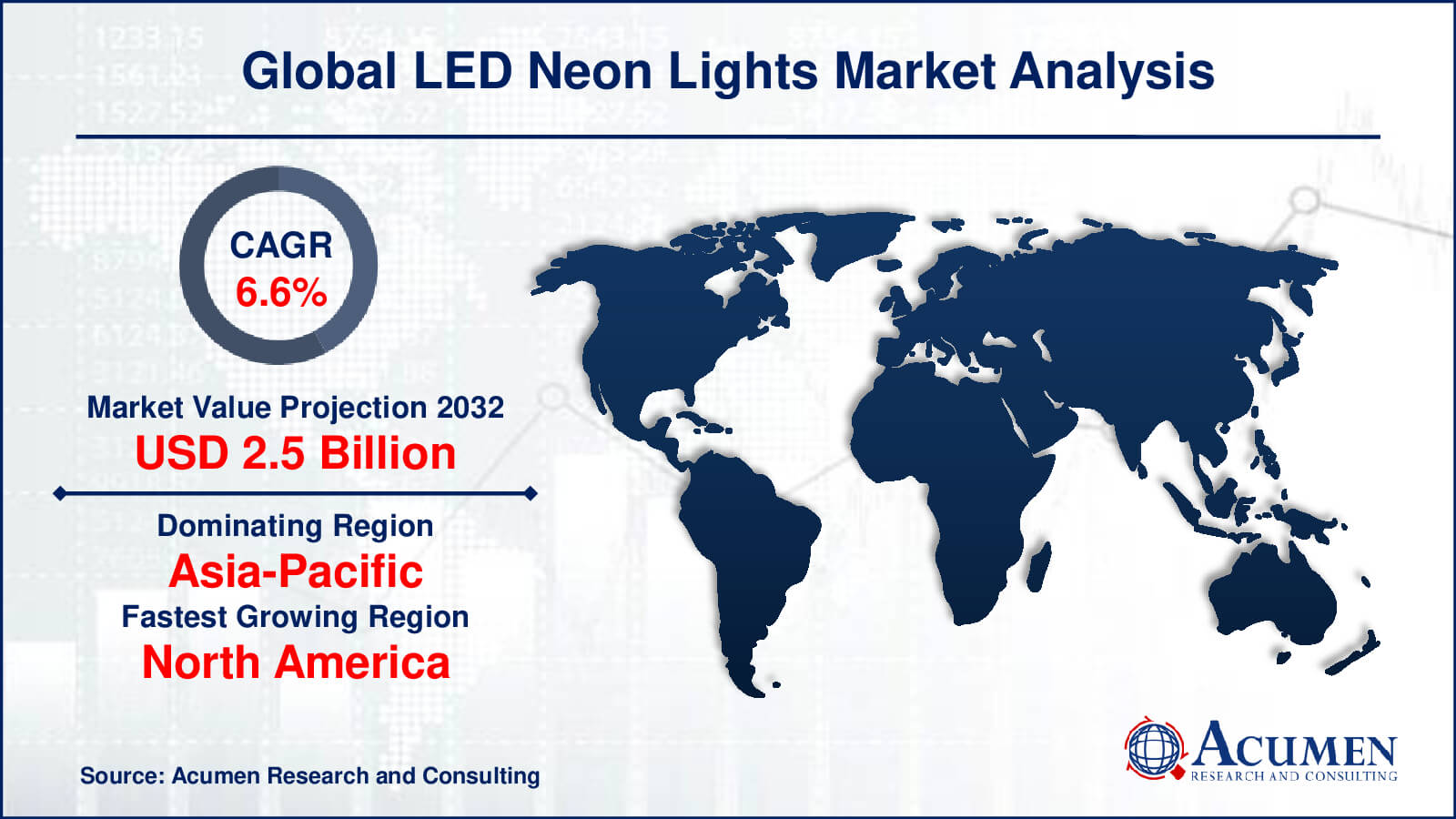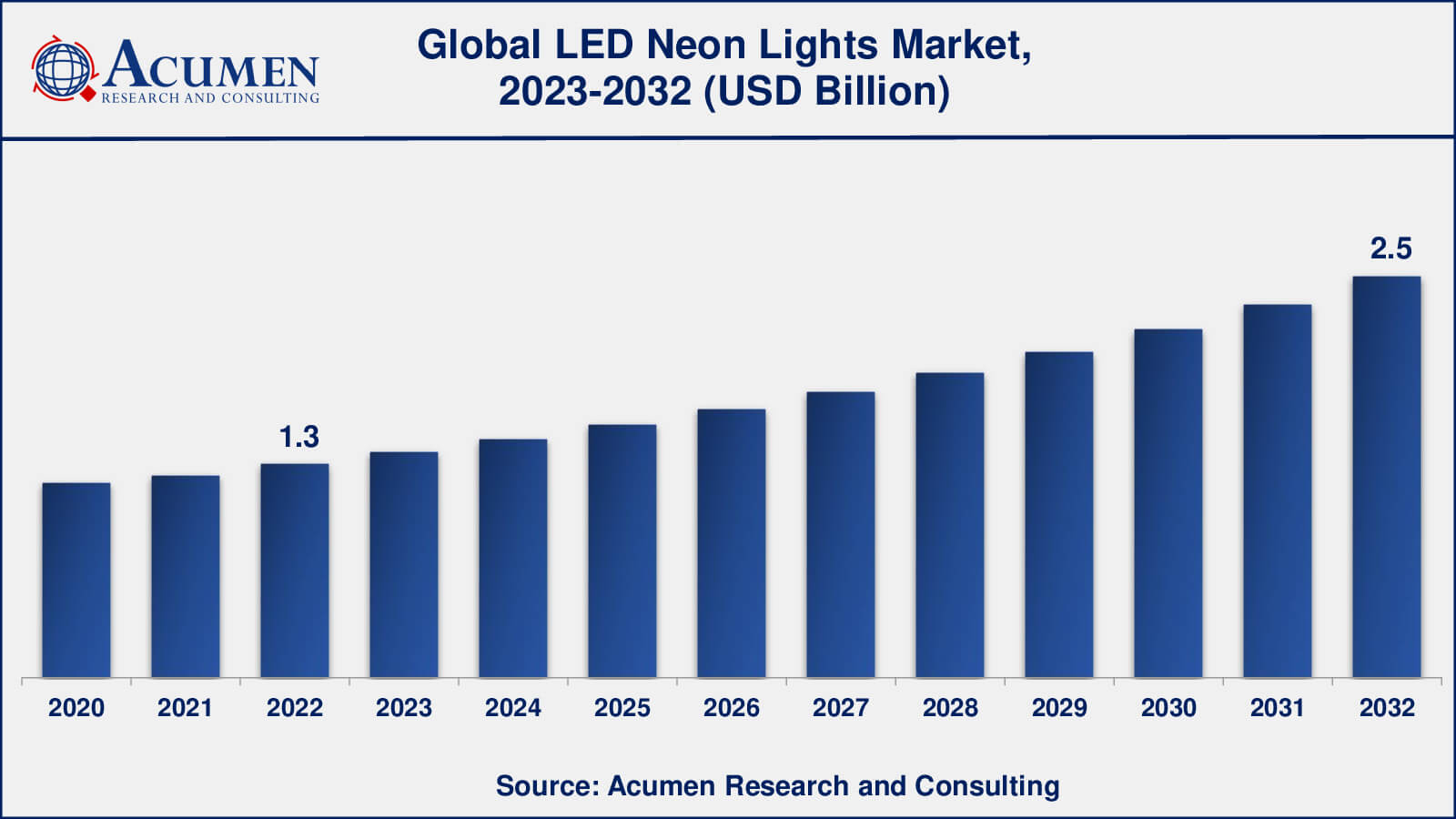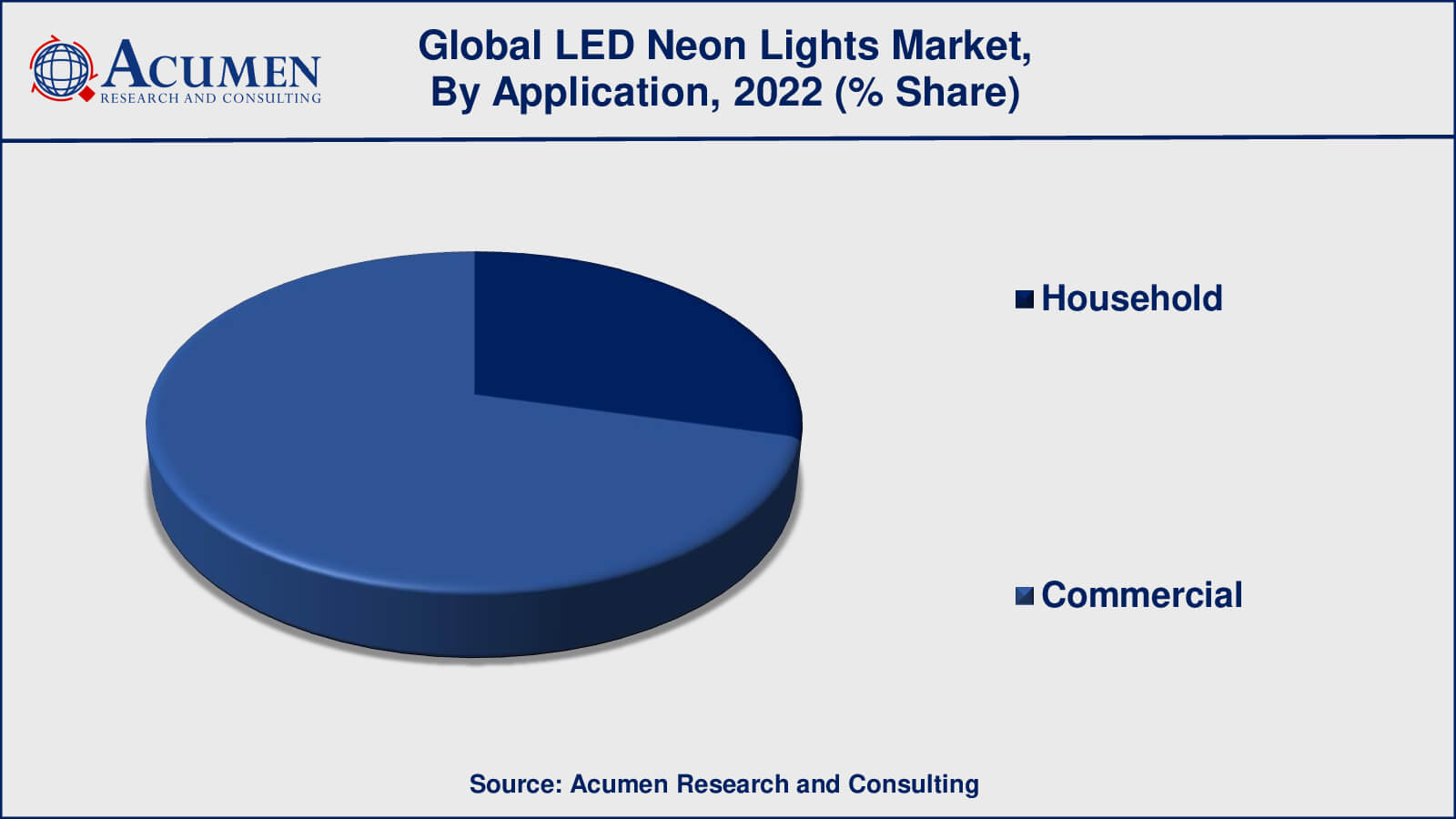LED Neon Lights Market Size - Global Industry, Share, Analysis, Trends and Forecast 2023 - 2032
Published :
Report ID:
Pages :
Format :
LED Neon Lights Market Size - Global Industry, Share, Analysis, Trends and Forecast 2023 - 2032
Report Coverage
- Industry Dynamics
- Market Size and Forecast Data
- Segment Analysis
- Competitive Landscape
- Regional Analysis with a Niche Focus on Country-Level Data
- High Level Analysis - Porter's, PESTEL, Value Chain, etc.
- Company Profiles of Key Players
- Option to Customize the Report As Per Your Specific Need
Request Sample Report
The global LED Neon Lights Market size was valued at USD 1.3 Billion in 2022 and is projected to attain USD 2.5 Billion by 2032 mounting at a CAGR of 6.6% from 2023 to 2032.
LED Neon Lights Market Highlights
- Global LED neon lights market revenue is poised to garner USD 2.5 billion by 2032 with a CAGR of 6.6% from 2023 to 2032
- Asia-Pacific LED neon lights market value occupied around USD 420 million in 2022
- North America LED neon lights market growth will record a CAGR of more than 7% from 2023 to 2032
- Among type, the silicone sub-segment occupied over US$ 864 million in revenue in 2022
- Based on application, the commercial sub-segment gathered around 71% share in 2022
- Increasing focus on sustainable and eco-friendly lighting solutions is a popular LED neon lights market trend that drives the industry demand

LED neon lights are a sort of lighting technology that mimics the appearance of classic neon lights but employs light-emitting diodes (LEDs) rather than gas-filled tubes. When an electric current runs through an LED, it emits light. LED neon lights provide various advantages over classic neon lights, including lower energy use, a longer lifespan, and improved durability. Because they are flexible and can be molded into a variety of forms, they are great for producing eye-catching signage, ornamental displays, and creative installations. LED neon lights have been increasingly popular in recent years due to its adaptability, eco-friendliness, and ability to create dazzling and vivid colors. They are widely utilized in commercial settings, architectural illumination, events, and home decor.

Global LED Neon Lights Market Dynamics
Market Drivers
- Energy efficiency and cost-effectiveness
- Long lifespan and low maintenance
- Versatility in design and applications
- Eco-friendliness and reduced carbon footprint
Market Restraints
- Initial higher costs compared to traditional lighting
- Limited availability of specialized designs and colors
- Dependency on electrical infrastructure and power supply
Market Opportunities
- Growing demand for energy-efficient lighting solutions
- Expanding applications in commercial and residential sectors
- Advancements in LED technology and customization options
LED Neon Lights Market Report Coverage
| Market | LED Neon Lights Market |
| LED Neon Lights Market Size 2022 | USD 1.3 Billion |
| LED Neon Lights Market Forecast 2032 | USD 2.5 Billion |
| LED Neon Lights Market CAGR During 2023 - 2032 | 6.6% |
| LED Neon Lights Market Analysis Period | 2020 - 2032 |
| LED Neon Lights Market Base Year | 2022 |
| LED Neon Lights Market Forecast Data | 2023 - 2032 |
| Segments Covered | By Type, By Application, And By Geography |
| Regional Scope | North America, Europe, Asia Pacific, Latin America, and Middle East & Africa |
| Key Companies Profiled | A1deSIGNS, Beyond LED Technology, Elemental LED, Elstar LED, Honest Exhibition Limited, INCISEON, LED Neon Flex, Lightstec, Nova Flex LED, SGi Lighting, and Solid Apollo LED. |
| Report Coverage |
Market Trends, Drivers, Restraints, Competitive Analysis, Player Profiling, Covid-19 Analysis, Regulation Analysis |
LED Neon Lights Market Insights
The LED neon lights market is driven by many major aspects that have led to its rise and attractiveness. The extraordinary energy efficiency and cost-effectiveness of LED neon lights is one of the key motivations. LED neon lights utilize substantially less electricity than classic neon lights, resulting in lower energy expenditures for consumers. LEDs' extended lifespan and low maintenance needs lead to long-term cost savings, making them an appealing investment for both companies and homes.
Another important factor is the design and application adaptability of LED neon lights. LED neon lights may be bent into a variety of shapes and colors, allowing designers and companies to create personalized signs and eye-catching displays. LED neon lights are versatile enough to be utilized for ornamental reasons, advertising, architectural illumination, and creative projects. This wide range of uses has raised demand for LED neon lights in a variety of sectors.
Additionally, the rising emphasis on eco-friendliness and sustainability has increased the use of LED neon lights. LED technology is less harmful to the environment than traditional neon lights, which use gas-filled tubes. LEDs do not contain toxic components like mercury and generate less trash. LED neon lights have gained popularity as businesses and customers seek environmentally aware products and solutions owing to their low carbon footprint and eco-friendly qualities.
Despite several drivers, the LED neon lights industry is constrained by a few factors. One of the key issues is that LED neon lights are initially more expensive than traditional lighting solutions. While LED technology has grown more inexpensive in recent years, the initial investment might still be a hindrance for certain potential clients, especially in cost-sensitive regions. However, it is critical to consider the long-term cost savings and benefits provided by LED neon lights, which can more than offset the initial expenditure.
Another issue is the scarcity of specialized LED neon light patterns and colors. While LED technology allows for a broad choice of colors, some elaborate and particular patterns, especially when compared to classic neon lights, may be difficult to produce with LED neon lights. However, continued improvements in LED technology and production techniques are increasingly expanding the possibilities for more customized and elaborate LED neon lighting alternatives.
Furthermore, the broad use of LED neon lights is contingent on the availability of a robust electrical infrastructure and a dependable power supply. The full potential of LED neon lights may not be realized in locations with insufficient or inconsistent electrical supply, hampered its adoption in specific places.
LED Neon Lights Market Segmentation
The worldwide market for LED neon lights is split based on type, application, and geography.
LED Neon Lights Types
- Silicone
- PVC
- Others

According to the LED neon lights industry analysis, PVC and silicone were the two most widely utilised materials in the LED neon lights market. Both materials have benefits and applications. PVC (polyvinyl chloride) is a frequently utilised material due to its low cost and simplicity of manufacture. It's used in interior applications including ornamental lights and residential installations. PVC has excellent light dispersion qualities and can easily moulded into a variety of forms and styles.
Silicone on the other hand, is well-known for its pliability, resilience, and resistance to UV radiation and high temperatures. It is frequently used for outdoor and commercial signs due to its ability to endure extreme weather conditions.
Furthermore, the "Others" category is likely to contain materials that are less often utilised, such as different types of plastics or specialised materials, that may have unique applications or niche usage in the LED neon lights industry.
LED Neon Lights Applications
- Household
- Commercial

The commercial application dominated the LED neon light industry. LED neon lights are widely utilised in the business sector for a variety of applications including signs, advertising, architectural illumination, and aesthetic displays. LED neon lights are frequently used in commercial facilities such as retail stores, restaurants, bars, hotels, and entertainment venues to create eye-catching and appealing displays in order to attract consumers and boost their brand image.
While LED neon lights are used in the home for decorative lighting and residential installations, the demand in the commercial sector is stronger owing to larger project scales and the necessity for colourful and attention-grabbing lighting solutions in commercial settings.
LED Neon Lights Market Regional Segmentation
North America
- U.S.
- Canada
Europe
- U.K.
- Germany
- France
- Spain
- Rest of Europe
Asia-Pacific
- India
- Japan
- China
- Australia
- South Korea
- Rest of Asia-Pacific
Latin America
- Brazil
- Mexico
- Rest of Latin America
The Middle East & Africa
- South Africa
- GCC Countries
- Rest of the Middle East & Africa (ME&A)
LED Neon Lights Market Regional Analysis
The Asia-Pacific region provided a major development opportunity for the LED neon lights industry. Rapid urbanization, greater infrastructure development, and rising disposable incomes in countries such as China, Japan, South Korea, and India resulted in an increase in commercial and residential construction projects. These factors contributed to an increase in the demand for LED neon lights in both indoor and outdoor applications.
North America, which included the United States and Canada, was an important market for LED neon lights. The sophisticated economies of the area, high consumer knowledge of energy-efficient lighting, and a rising desire for eco-friendly products all contributed to the region's strong demand for LED neon lights. In this region, commercial uses like as advertising and architectural illumination were particularly prevalent.
Europe has demonstrated a significant desire for LED neon lights, with Germany, the United Kingdom, and France leading the way. Strict energy efficiency and sustainability laws, together with an increasing inclination for energy-saving lighting solutions, encouraged the development of LED neon lights in this region.
LED Neon Lights Market Players
Some of the top LED neon lights companies offered in our report include A1deSIGNS, Beyond LED Technology, Elemental LED, Elstar LED, Honest Exhibition Limited, INCISEON, LED Neon Flex, Lightstec, Nova Flex LED, SGi Lighting, and Solid Apollo LED.
Frequently Asked Questions
What was the size of the global LED neon lights market in 2022?
The size of LED neon lights market was USD 1.3 billion in 2022.
What is the LED neon lights market CAGR from 2023 to 2032?
The LED neon lights market CAGR during the analysis period of 2023 to 2032 is 6.6%.
Which are the key players in the LED neon lights market?
The key players operating in the global LED neon lights market are including A1deSIGNS, Beyond LED Technology, Elemental LED, Elstar LED, Honest Exhibition Limited, INCISEON, LED Neon Flex, Lightstec, Nova Flex LED, SGi Lighting, and Solid Apollo LED.
Which region dominated the global LED neon lights market share?
Asia-Pacific region held the dominating position in LED neon lights industry during the analysis period of 2023 to 2032.
Which region registered fastest CAGR from 2023 to 2032?
North America region exhibited fastest growing CAGR for market of LED neon lights during the analysis period of 2023 to 2032.
What are the current trends in the global LED neon lights industry?
The current trends and dynamics in the LED neon lights industry include energy efficiency and cost-effectiveness, long lifespan and low maintenance, and versatility in design and applications.
Which type held the maximum share in 2022?
The silicone type held the maximum share of the LED neon lights industry.



